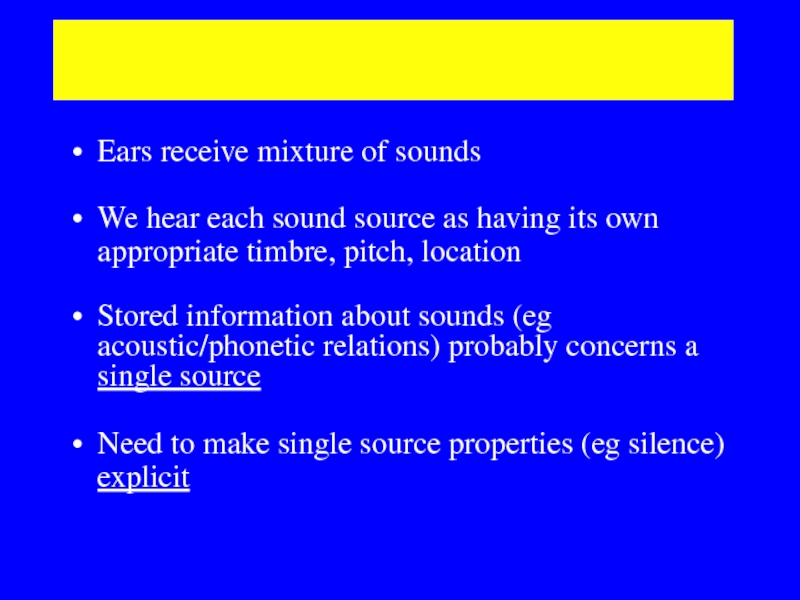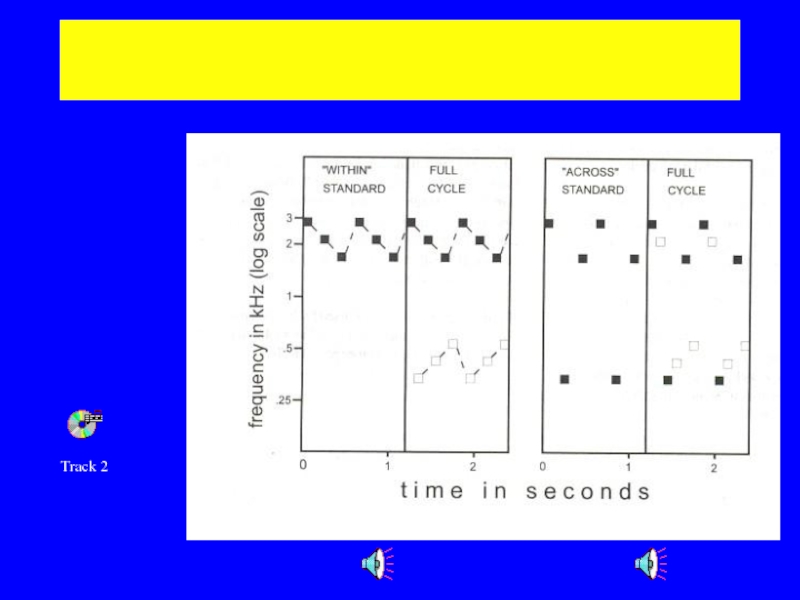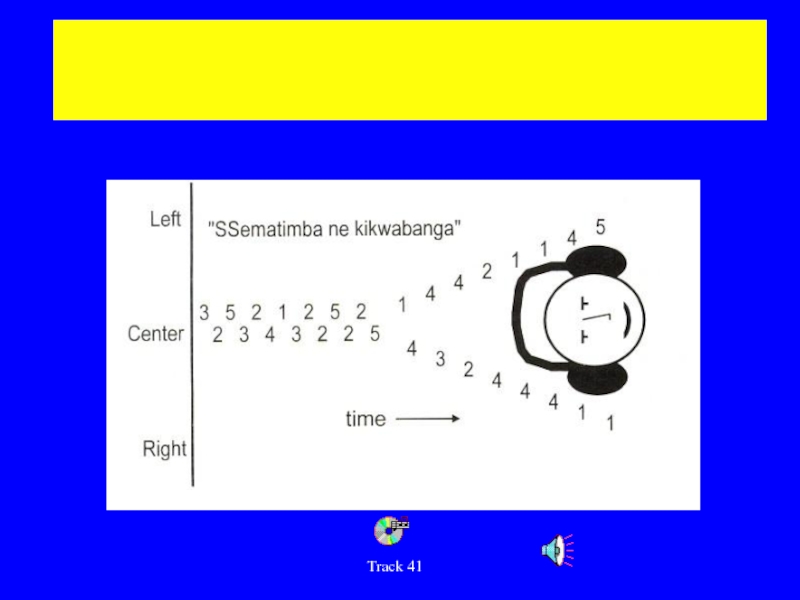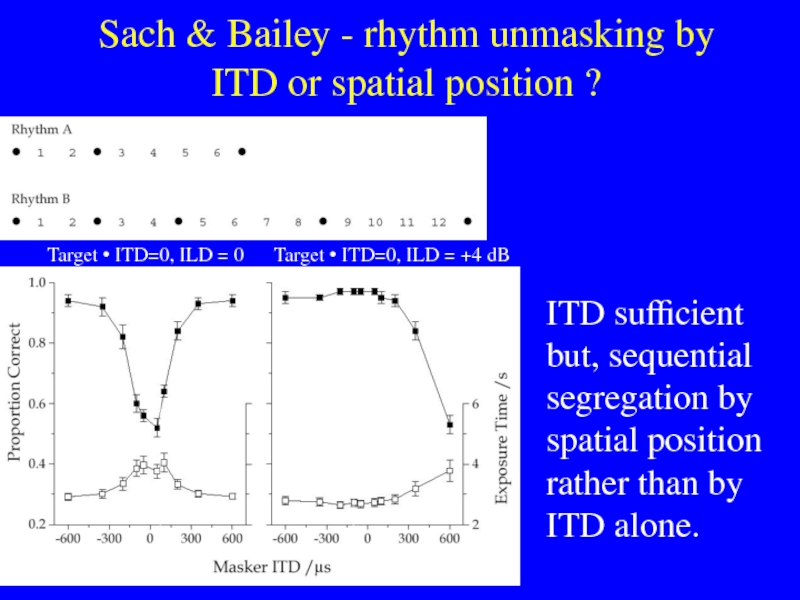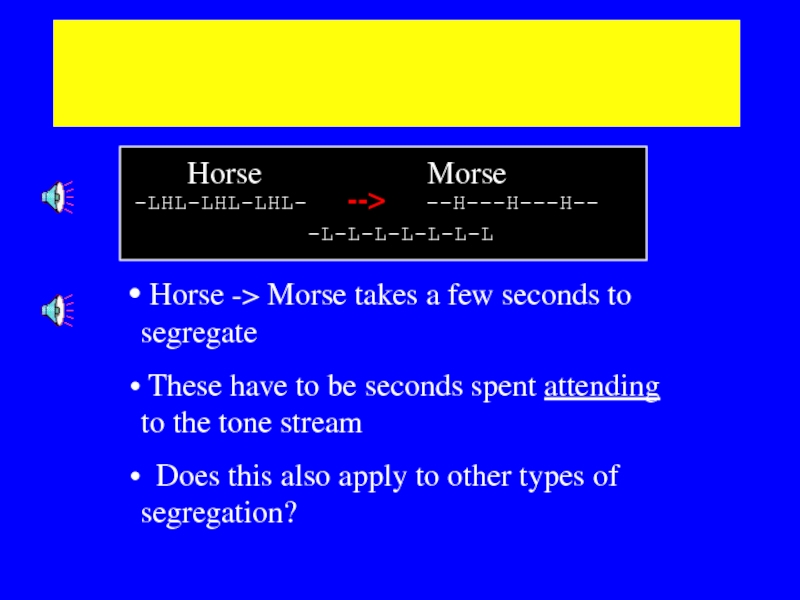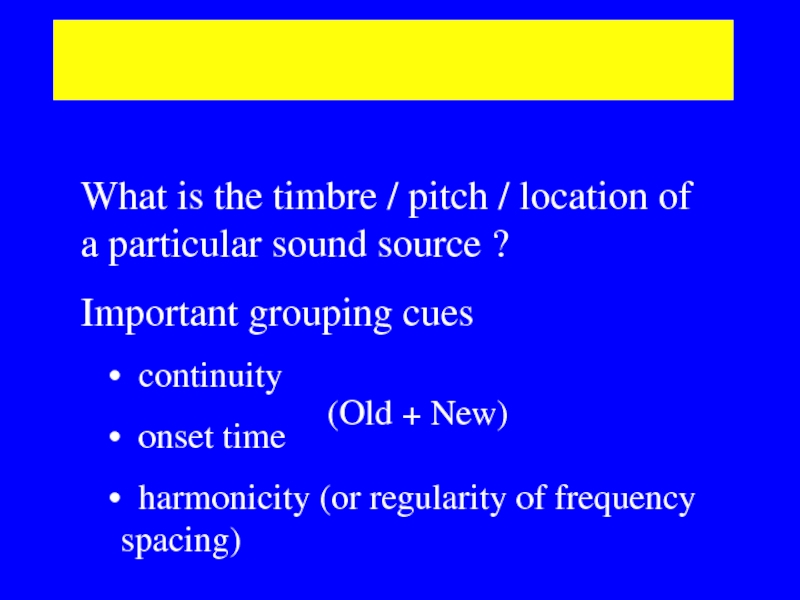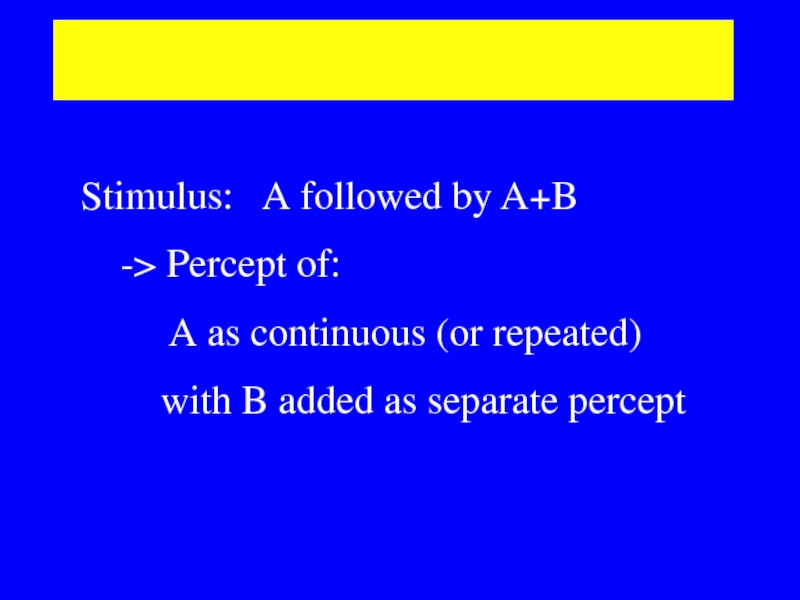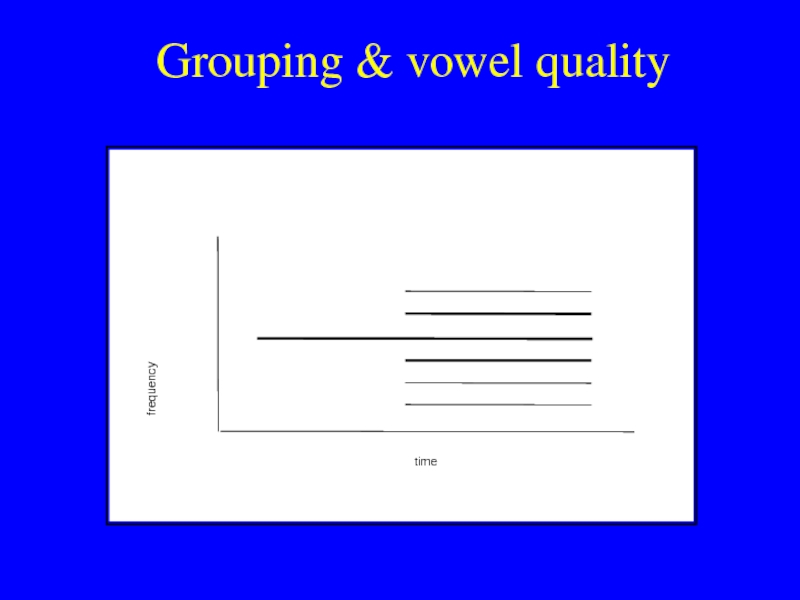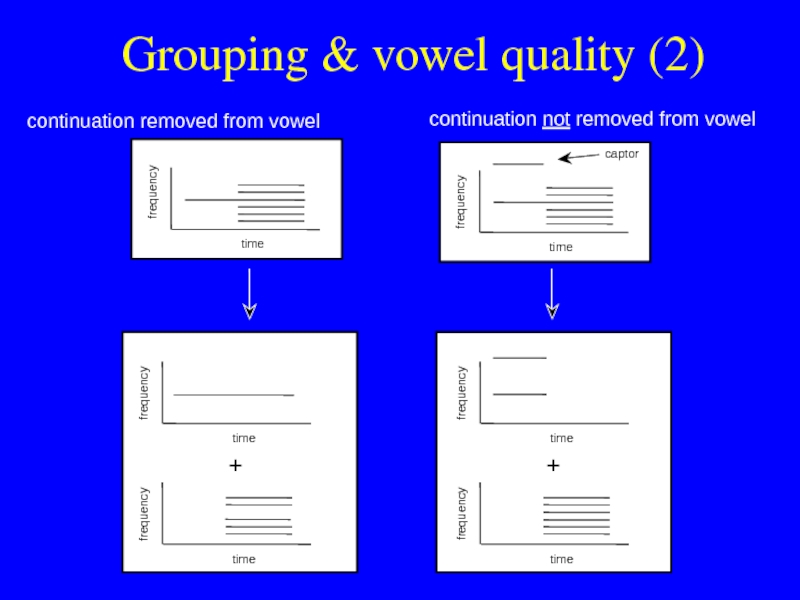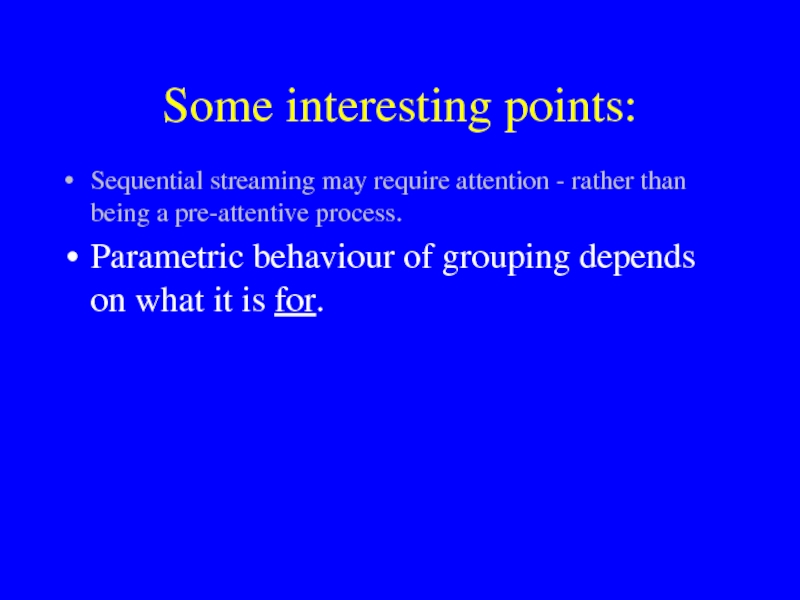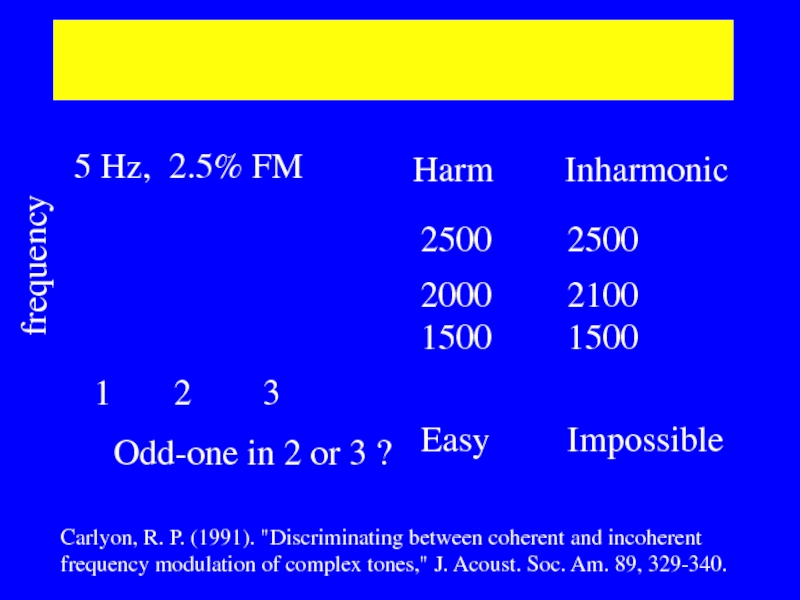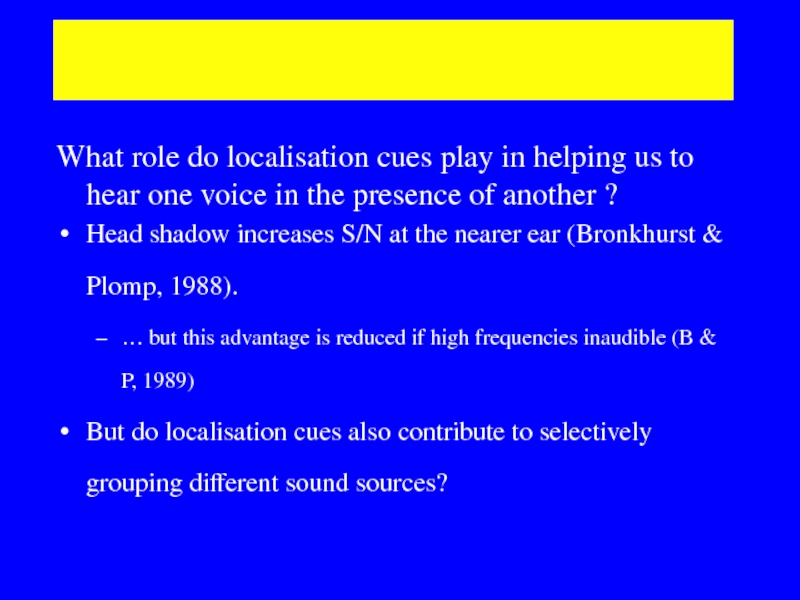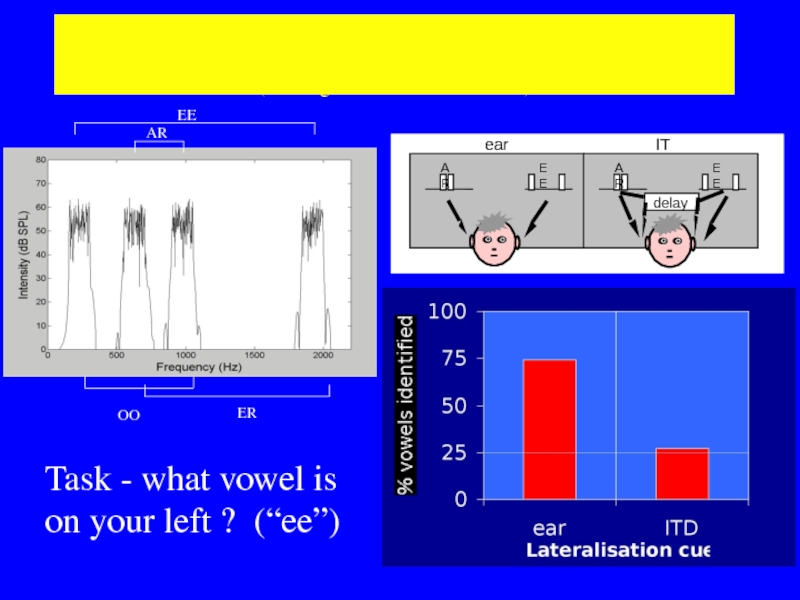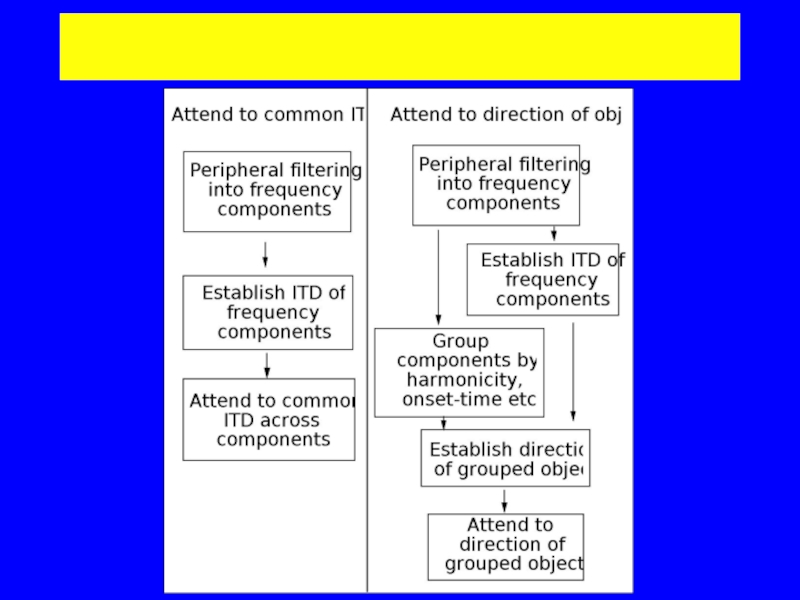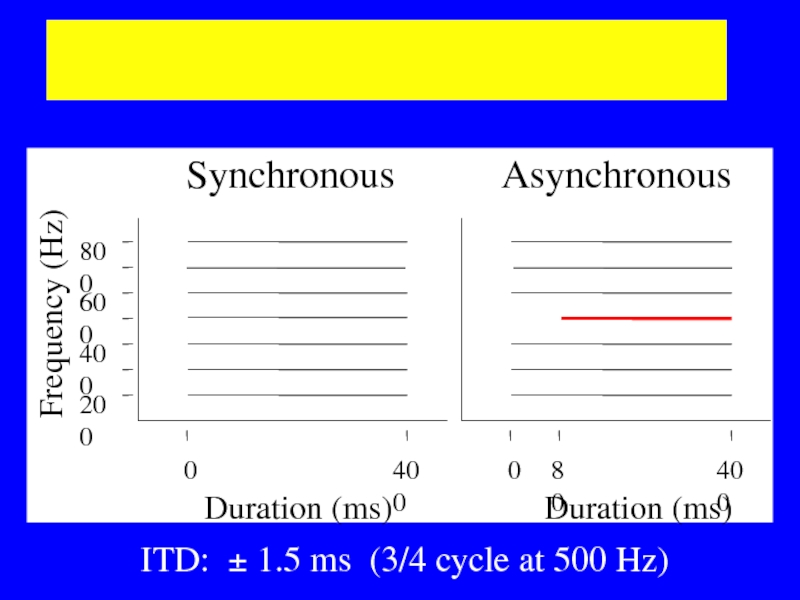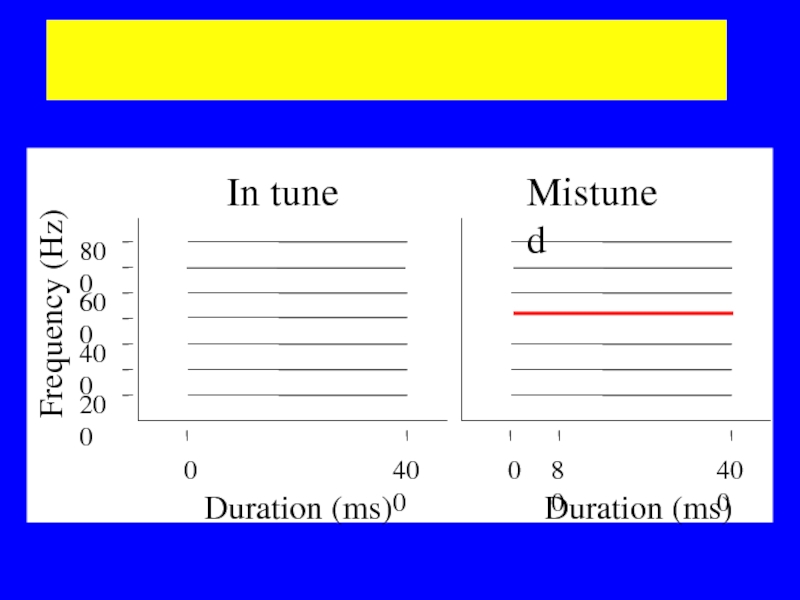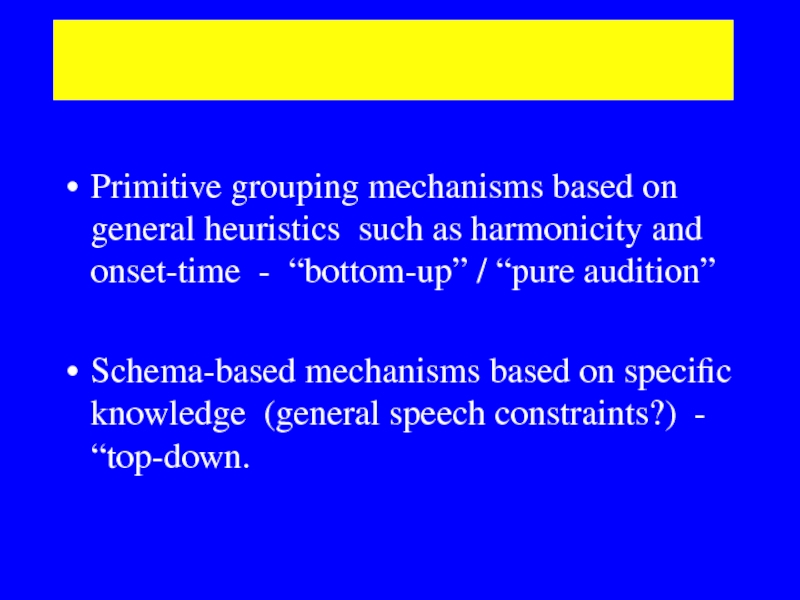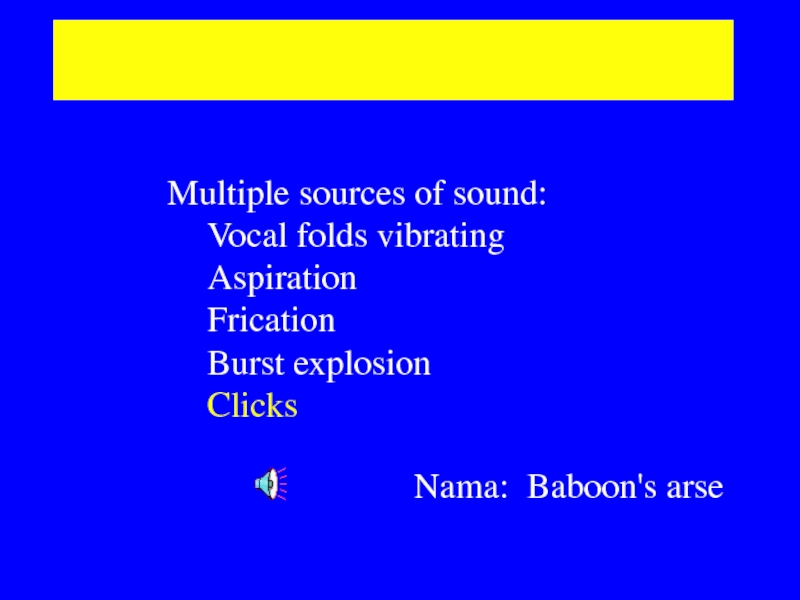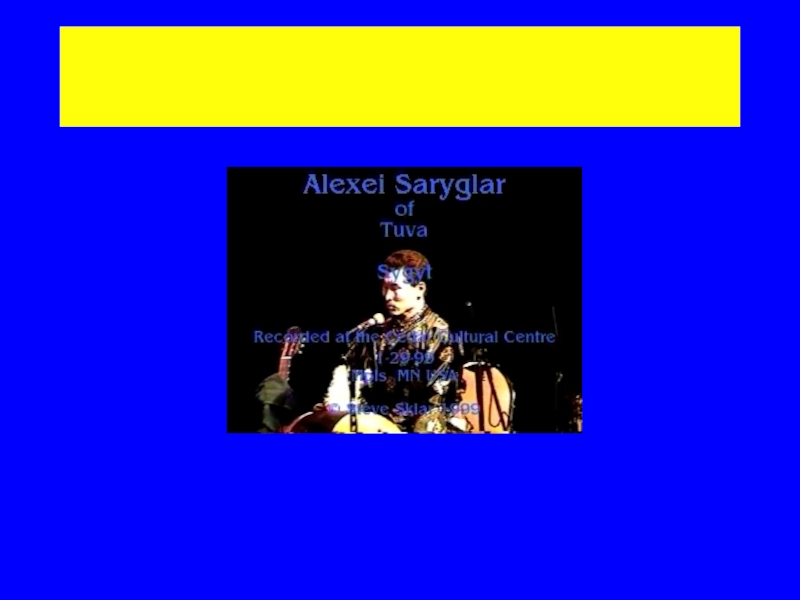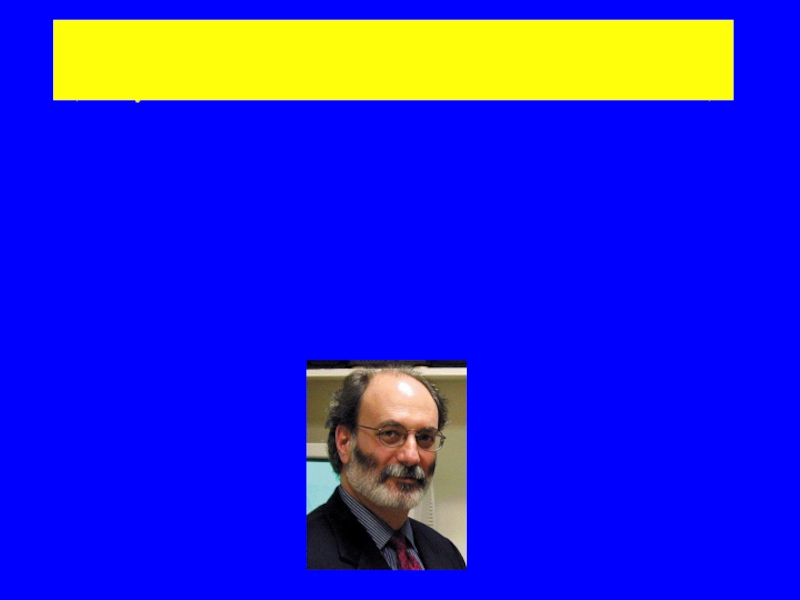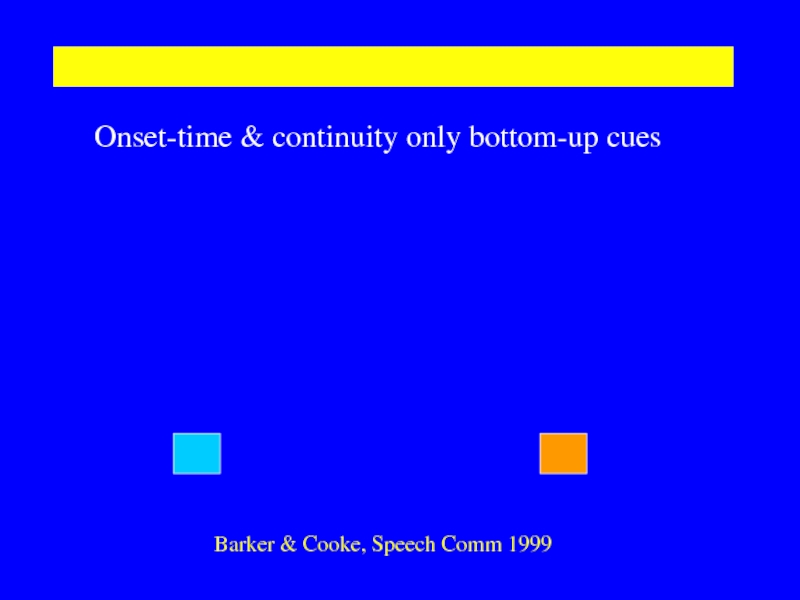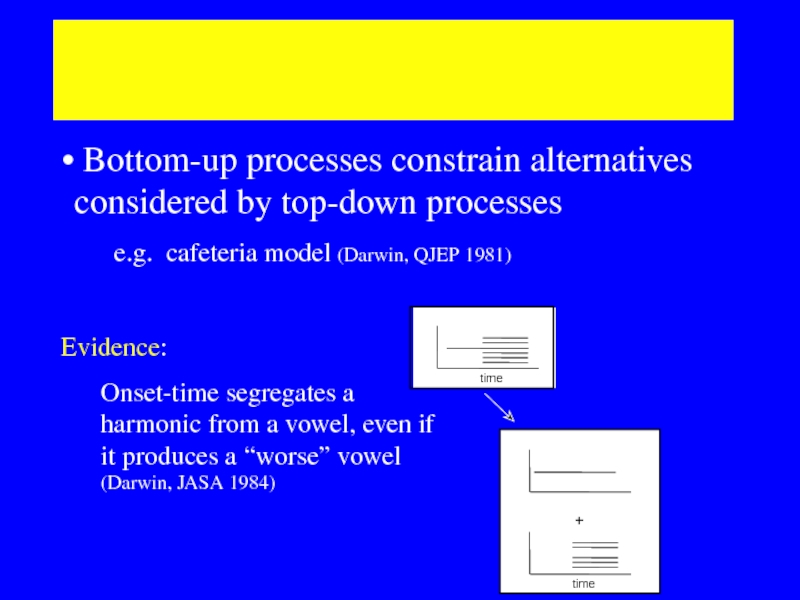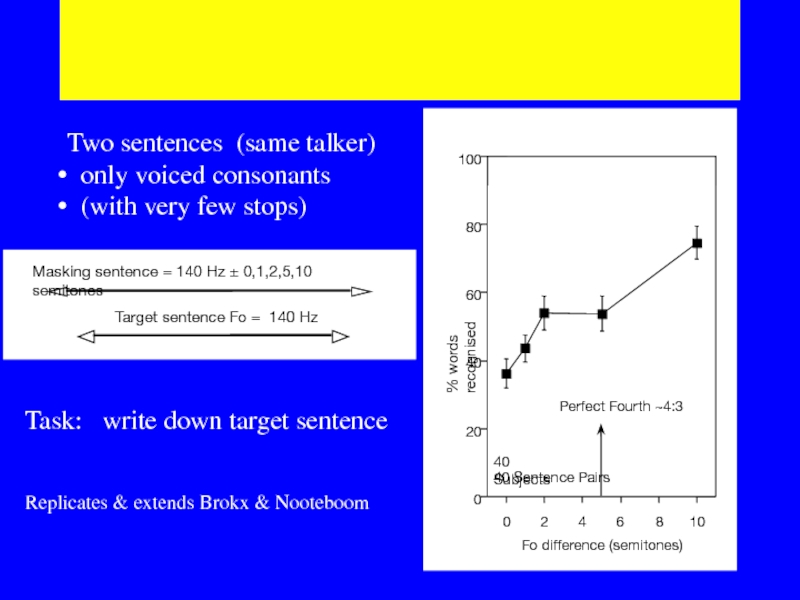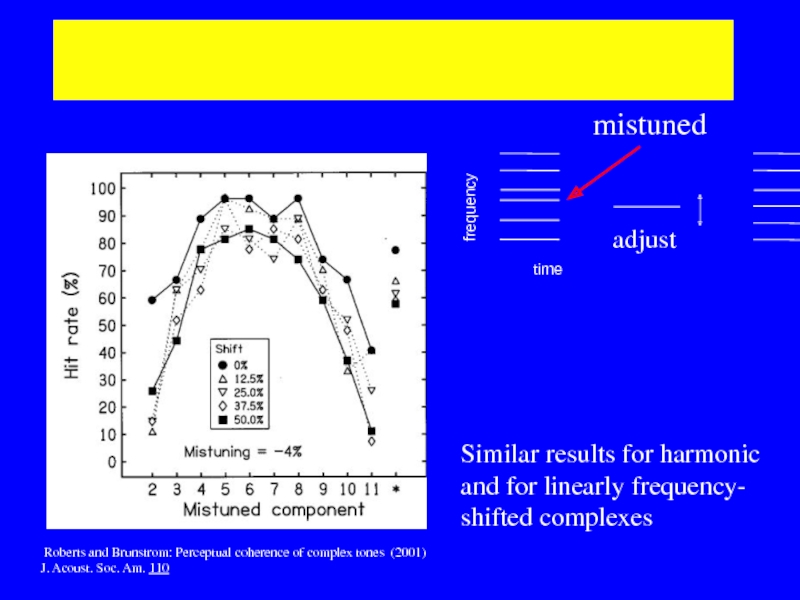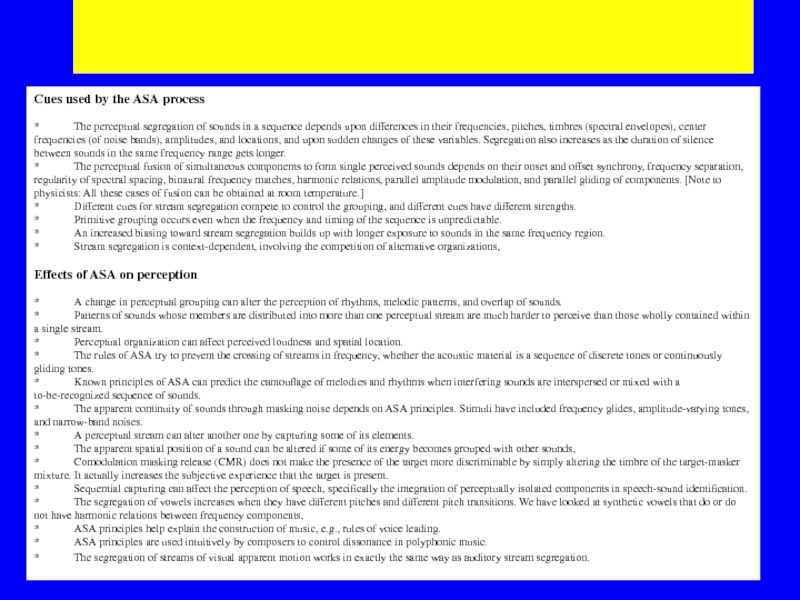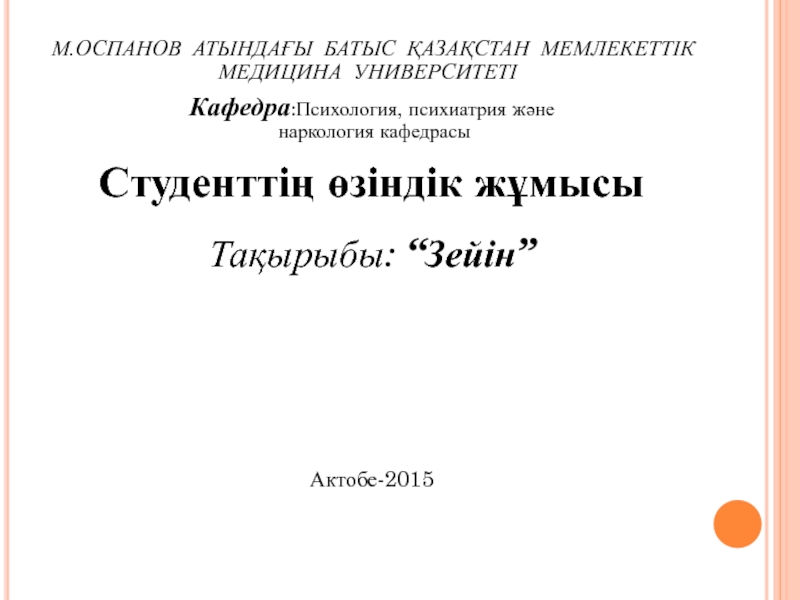- Главная
- Разное
- Дизайн
- Бизнес и предпринимательство
- Аналитика
- Образование
- Развлечения
- Красота и здоровье
- Финансы
- Государство
- Путешествия
- Спорт
- Недвижимость
- Армия
- Графика
- Культурология
- Еда и кулинария
- Лингвистика
- Английский язык
- Астрономия
- Алгебра
- Биология
- География
- Детские презентации
- Информатика
- История
- Литература
- Маркетинг
- Математика
- Медицина
- Менеджмент
- Музыка
- МХК
- Немецкий язык
- ОБЖ
- Обществознание
- Окружающий мир
- Педагогика
- Русский язык
- Технология
- Физика
- Философия
- Химия
- Шаблоны, картинки для презентаций
- Экология
- Экономика
- Юриспруденция
Source Segregation. Chris Darwin. Experimental Psychology. University of Sussex презентация
Содержание
- 1. Source Segregation. Chris Darwin. Experimental Psychology. University of Sussex
- 3. Need for sound segregation Ears receive mixture
- 4. Making properties explicit Single-source properties not explicit
- 5. Mechanisms of segregation Primitive grouping mechanisms based
- 6. Segregation of simple musical sounds Successive segregation
- 7. Successive grouping by frequency Track 8 Track 7 Bugandan xylophone music: “Ssematimba ne Kikwabanga”
- 8. Not peripheral channelling Streaming occurs for sounds
- 9. Huggins pitch ∆ø
- 10. Successive grouping by frequency Track 2
- 11. Successive grouping by spatial separation Track 41
- 12. Sach & Bailey - rhythm unmasking by
- 13. Build-up of segregation Horse
- 14. Some interesting points: Sequential streaming may require
- 15. Attention necessary for build-up of streaming
- 16. Capturing a component from a mixture by
- 17. Simultaneous grouping What is the timbre /
- 18. Bregman’s Old + New principle Stimulus:
- 19. B MAMB Old+New Heuristic A MAMB
- 20. Percept M
- 21. Grouping & vowel quality
- 22. Grouping & vowel quality (2)
- 23. Onset-time: allocation is subtractive not exclusive
- 24. Asynchrony & vowel quality
- 25. Mistuning & pitch Mean pitch shift
- 26. Onset asynchrony & pitch Onset Asynchrony
- 27. Some interesting points: Sequential streaming may require
- 28. Grouping for Effectiveness of a parameter
- 29. Minimum onset needed for:
- 30. Grouping not absolute and independent of classification group classify
- 31. Apparent continuity Track 28 If B would
- 32. Continuity & grouping 1. Pulsing complex Pulsing
- 33. Some interesting points: Sequential streaming may require
- 34. Carlyon: across-frequency FM coherence Odd-one in 2
- 35. Role of localisation cues What role do
- 36. Some interesting points: Sequential streaming may require
- 37. Separating two simultaneous sound sources Noise bands
- 38. Segregation by ear but not by ITD
- 39. Two models of attention
- 40. Phase Ambiguity 500 Hz: period
- 41. Disambiguating phase-ambiguity Narrowband noise at 500
- 42. Resolving phase ambiguity 500 Hz: period
- 43. Segregation by onset-time 200 400
- 44. Segregated tone changes location -20 0
- 45. Segregation by mistuning 200 400
- 46. Mistuned tone changes location
- 47. Mechanisms of segregation Primitive grouping mechanisms based
- 48. Hierarchy of sound sources ? Orchestra 1°
- 49. Is speech a single sound source ?
- 50. Tuvan throat music
- 51. Tuvan throat music
- 52. Sine-wave speech: one is OK... (Bailey et
- 53. SWS: but how about two?
- 54. Both approaches could be true Bottom-up
- 55. Low-level cues for separating a mixture of
- 56. ΔFo between two sentences (Bird &
- 57. Harmonicity or regular spacing? Roberts and
- 58. Auditory grouping and ICA / BSS Do
- 59. Speech music
- 60. Speech music
- 61. Speech music
- 62. Bregman long summary Cues used by the
Слайд 3Need for sound segregation
Ears receive mixture of sounds
We hear each sound
Stored information about sounds (eg acoustic/phonetic relations) probably concerns a single source
Need to make single source properties (eg silence) explicit
Слайд 4Making properties explicit
Single-source properties not explicit in input signal
eg silence (Darwin
NB experience of yodelling may alter your susceptibility to this effect
Слайд 5Mechanisms of segregation
Primitive grouping mechanisms based on general heuristics such as
Schema-based mechanisms based on specific knowledge (general speech constraints?) - “top-down.
Слайд 6Segregation of simple musical sounds
Successive segregation
Different frequency (or pitch)
Different spatial position
Different
Simultaneous segregation
Different onset-time
Irregular spacing in frequency
Location (rather unreliable)
Uncorrelated FM not used
Слайд 7Successive grouping by frequency
Track 8
Track 7
Bugandan xylophone music: “Ssematimba ne Kikwabanga”
Слайд 8Not peripheral channelling
Streaming occurs for sounds
with same auditory excitation pattern,
with Huggins pitch sounds that are only defined binaurally Carlyon & Akeroyd
Слайд 12Sach & Bailey - rhythm unmasking by ITD or spatial position
ITD sufficient but, sequential segregation by spatial position rather than by ITD alone.
Target • ITD=0, ILD = 0
Target • ITD=0, ILD = +4 dB
Masker
Слайд 13
Build-up of segregation
Horse Morse
-LHL-LHL-LHL-
-L-L-L-L-L-L-L
Segregation takes a few seconds to build up.
Then between-stream temporal / rhythmic judgments are very difficult
Слайд 14Some interesting points:
Sequential streaming may require attention - rather than being
Слайд 15
Attention necessary for build-up of streaming (Carlyon et al, JEP:HPP 2000)
Horse Morse
-LHL-LHL-LHL- --> --H---H---H--
-L-L-L-L-L-L-L
Horse -> Morse takes a few seconds to segregate
These have to be seconds spent attending to the tone stream
Does this also apply to other types of segregation?
Слайд 16Capturing a component from a mixture by frequency proximity
A-B
A-BC
Freq separation of AB
Harmonicity & synchrony of BC
Слайд 17Simultaneous grouping
What is the timbre / pitch / location of a
Important grouping cues
continuity
onset time
harmonicity (or regularity of frequency spacing)
(Old + New)
Слайд 18Bregman’s Old + New principle
Stimulus: A followed by A+B
-> Percept
A as continuous (or repeated)
with B added as separate percept
Слайд 23Onset-time:
allocation is subtractive not exclusive
Bregman’s Old-plus-New heuristic
Indicates importance of
Слайд 24Asynchrony & vowel quality
90 ms
T
Onset Asynchrony T (ms)
F1 boundary (Hz)
8 subjects
No
Слайд 26
Onset asynchrony & pitch
Onset Asynchrony T (ms)
Mean pitch shift (Hz)
8 subjects
±3%
90 ms
T
Слайд 27Some interesting points:
Sequential streaming may require attention - rather than being
Parametric behaviour of grouping depends on what it is for.
Слайд 28Grouping for
Effectiveness of a parameter on grouping depends on the
10-ms onset time allows a harmonic to be heard out
40-ms onset-time needed to remove from vowel quality
>100-ms needed to remove it from pitch.
Слайд 31Apparent continuity
Track 28
If B would have masked if it HAD been
Слайд 32Continuity & grouping
1. Pulsing complex
Pulsing high tone
Steady low tone
Group tones;
Слайд 33Some interesting points:
Sequential streaming may require attention - rather than being
Parametric behaviour of grouping depends on what it is for.
Not everything that is obvious on an auditory spectrogram can be used :
FM of Fo irrelevant for segregation (Carlyon, JASA 1991; Summerfield & Culling 1992)
Слайд 34Carlyon: across-frequency FM coherence
Odd-one in 2 or 3 ?
5 Hz, 2.5%
Carlyon, R. P. (1991). "Discriminating between coherent and incoherent frequency modulation of complex tones," J. Acoust. Soc. Am. 89, 329-340.
Слайд 35Role of localisation cues
What role do localisation cues play in helping
Head shadow increases S/N at the nearer ear (Bronkhurst & Plomp, 1988).
… but this advantage is reduced if high frequencies inaudible (B & P, 1989)
But do localisation cues also contribute to selectively grouping different sound sources?
Слайд 36Some interesting points:
Sequential streaming may require attention - rather than being
Parametric behaviour of grouping depends on what it is for.
Not everything that is obvious on an auditory spectrogram can be used :
FM of Fo irrelevant for segregation (Carlyon, JASA 1991; Summerfield & Culling 1992)
Although we can group sounds by ear, ITDs by themselves remarkably useless for simultaneous grouping. Group first then localise grouped object.
Слайд 37Separating two simultaneous sound sources
Noise bands played to different ears group
Noise bands differing in ITD do not group by ear
Слайд 38Segregation by ear but not by ITD
(Culling & Summerfield 1995)
Task
Слайд 40Phase Ambiguity
500 Hz: period = 2ms
R leads by 1.5 ms
L leads
L
L
R
cross-correlation peaks at +0.5ms and -1.5ms
auditory system weighted toone closest to zero
500-Hz pure tone leading in Right ear by 1.5 ms
Heard on Left side
Слайд 41Disambiguating phase-ambiguity
Narrowband noise at 500 Hz with ITD of 1.5
Increasing noise bandwidth changes location to the leading side.
Explained by across-frequency consistency of ITD.
(Jeffress, Trahiotis & Stern)
Слайд 42Resolving phase ambiguity
500 Hz: period = 2ms
L lags by 1.5 ms
or
L leads by 0.5 ms ?
-2.5
200
800
600
400
-0.5
1.5
3.5
Delay of cross-correlator ms
Frequency of auditory filter Hz
300 Hz: period = 3.3ms
R
R
L
L
R
Actual delay
Left ear actually lags by 1.5 ms
L lags by 1.5 ms
or
L leads by 1.8 ms ?
R
Слайд 43Segregation by onset-time
200
400
600
800
Frequency (Hz)
Duration (ms)
0
400
Duration (ms)
0
80
400
Synchronous
Asynchronous
ITD: ± 1.5 ms (3/4 cycle
Слайд 44Segregated tone changes location
-20
0
20
0
20
40
80
Onset Asynchrony (ms)
Pointer IID (dB)
Pure
Complex
R
L
Слайд 45Segregation by mistuning
200
400
600
800
Frequency (Hz)
Duration (ms)
0
400
Duration (ms)
0
80
400
In tune
Mistuned
Слайд 47Mechanisms of segregation
Primitive grouping mechanisms based on general heuristics such as
Schema-based mechanisms based on specific knowledge (general speech constraints?) - “top-down.
Слайд 48Hierarchy of sound sources ?
Orchestra
1° Violin section
Leader
Chord
Lowest note
Attack
2° violins…
Corresponding hierarchy of
Слайд 49Is speech a single sound source ?
Multiple sources of sound:
Vocal folds
Aspiration
Frication
Burst explosion
Clicks
Nama: Baboon's arse
Слайд 53SWS: but how about two?
Onset-time & continuity only bottom-up cues
Barker &
Слайд 54Both approaches could be true
Bottom-up processes constrain alternatives considered by
e.g. cafeteria model (Darwin, QJEP 1981)
Evidence:
Onset-time segregates a harmonic from a vowel, even if it produces a “worse” vowel (Darwin, JASA 1984)
Слайд 55Low-level cues for separating a mixture of two sounds such as
Look for:
harmonic series
sounds starting at the same time
Слайд 56
ΔFo between two sentences
(Bird & Darwin 1998; after Brokx & Nooteboom,
% words recognised
Fo difference (semitones)
40 Subjects
40 Sentence Pairs
Perfect Fourth ~4:3
Target sentence Fo = 140 Hz
Masking sentence = 140 Hz ± 0,1,2,5,10 semitones
Two sentences (same talker)
only voiced consonants
(with very few stops)
Task: write down target sentence
Replicates & extends Brokx & Nooteboom
Слайд 57Harmonicity or regular spacing?
Roberts and Brunstrom: Perceptual coherence of complex
J. Acoust. Soc. Am. 110
time
frequency
adjust
mistuned
Similar results for harmonic
and for linearly frequency-
shifted complexes
Слайд 58Auditory grouping and ICA / BSS
Do grouping principles work because they
If so, why do the parametric values vary with the task?
Слайд 62Bregman long summary
Cues used by the ASA process
* The perceptual segregation of
* The perceptual fusion of simultaneous components to form single perceived sounds depends on their onset and offset synchrony, frequency separation, regularity of spectral spacing, binaural frequency matches, harmonic relations, parallel amplitude modulation, and parallel gliding of components. [Note to physicists: All these cases of fusion can be obtained at room temperature.]
* Different cues for stream segregation compete to control the grouping, and different cues have different strengths.
* Primitive grouping occurs even when the frequency and timing of the sequence is unpredictable.
* An increased biasing toward stream segregation builds up with longer exposure to sounds in the same frequency region.
* Stream segregation is context-dependent, involving the competition of alternative organizations,
Effects of ASA on perception
* A change in perceptual grouping can alter the perception of rhythms, melodic patterns, and overlap of sounds.
* Patterns of sounds whose members are distributed into more than one perceptual stream are much harder to perceive than those wholly contained within a single stream.
* Perceptual organization can affect perceived loudness and spatial location.
* The rules of ASA try to prevent the crossing of streams in frequency, whether the acoustic material is a sequence of discrete tones or continuously gliding tones.
* Known principles of ASA can predict the camouflage of melodies and rhythms when interfering sounds are interspersed or mixed with a to-be-recognized sequence of sounds.
* The apparent continuity of sounds through masking noise depends on ASA principles. Stimuli have included frequency glides, amplitude-varying tones, and narrow-band noises.
* A perceptual stream can alter another one by capturing some of its elements.
* The apparent spatial position of a sound can be altered if some of its energy becomes grouped with other sounds,
* Comodulation masking release (CMR) does not make the presence of the target more discriminable by simply altering the timbre of the target-masker mixture. It actually increases the subjective experience that the target is present.
* Sequential capturing can affect the perception of speech, specifically the integration of perceptually isolated components in speech-sound identification.
* The segregation of vowels increases when they have different pitches and different pitch transitions. We have looked at synthetic vowels that do or do not have harmonic relations between frequency components,
* ASA principles help explain the construction of music, e.g., rules of voice leading.
* ASA principles are used intuitively by composers to control dissonance in polyphonic music.
* The segregation of streams of visual apparent motion works in exactly the same way as auditory stream segregation.


